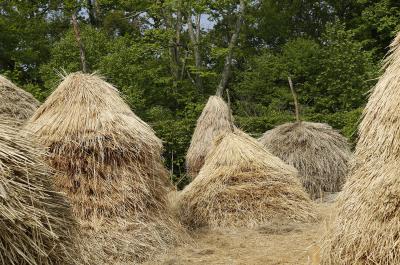15. Des meules impressionnantes

In each stack, some painters have been able to see qualities that involve our perspective in fleeting intentions and make us aware of the phenomena of light vibration. The interest that Claude Monet paid them has been an eye-opener for us, revealing the full extent of the beauty of this material. But it isn’t enough to take this single perspective if we want to capture the full force of the object. For there is also something wholly surprising about the form of stacks that have become colossal from the accumulation of countless flimsy blades of straw. Building a stack of hay has some parallels with the construction of a building: it is made stable through the forces of its gravity and its shape is a result of its function. In the same way, each culture has its own technique for erecting the structure – which brings about the possibility of a certain architecture of the stack: tall and cone-shaped in Poland, stack-packed landscapes in Romania and stacking on horizontal bars in Slovakia. It is through the different perspectives and uses we give to it that each stack embodies a certain stirring up of the senses and a new perspective bestowed upon plants.
Designer

“Influenced by two years of space-design project teaching, my interests as a sculptor, which were rather more general at art school, rapidly focused on in-situ production of large-scale artistic installations (landscaping and architecture). I try to bring my works into being in wider contexts than galleries or museums can provide. It is no longer a question of something simply to be looked at, but rather of a space to live in. Sculpture becomes a physical experience, set in real space and time, accessible and common to all. The challenge usually lies in drawing out the visual potential of the setting, in order to make full use of or, better still, interweave with it.”



